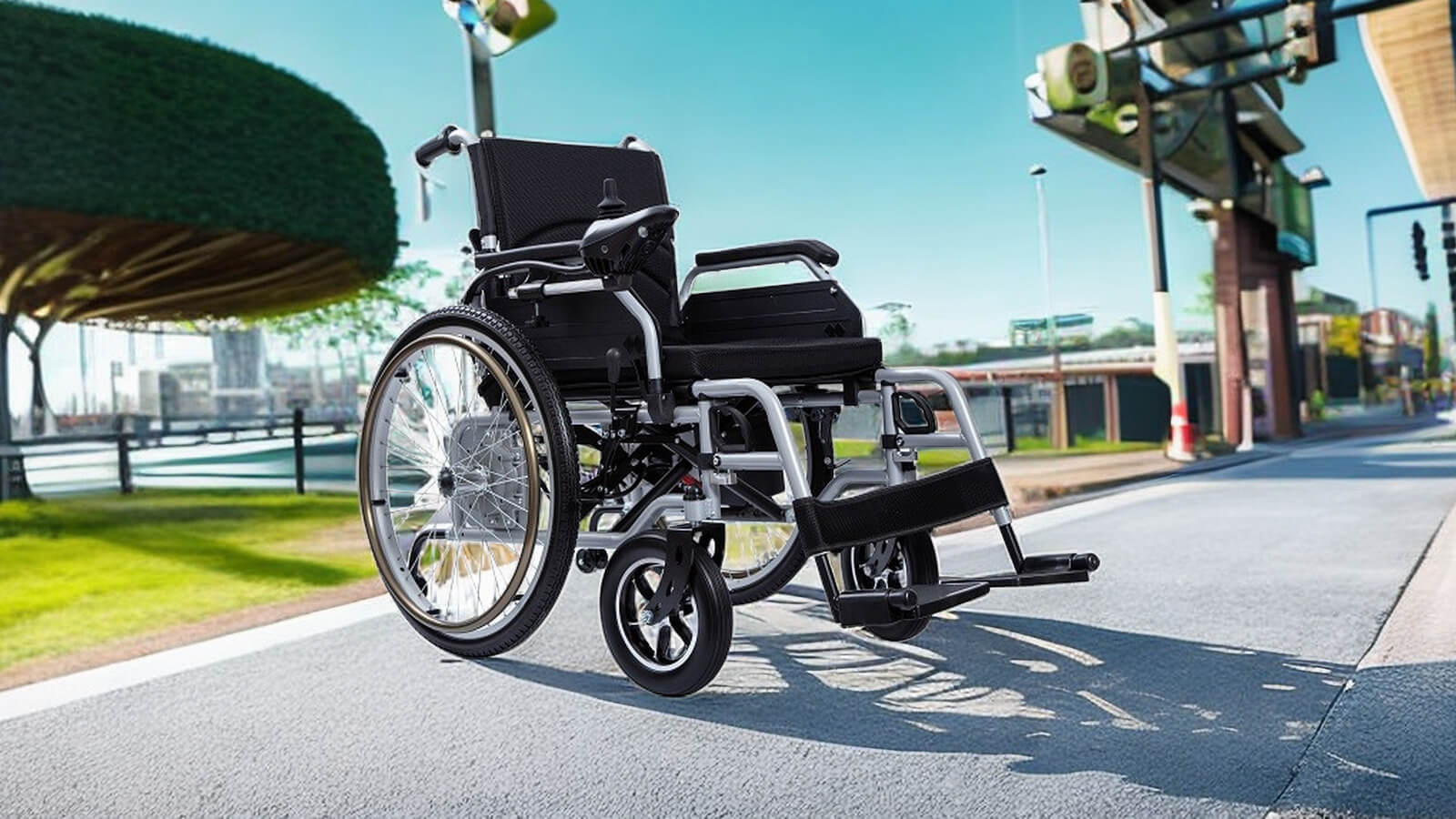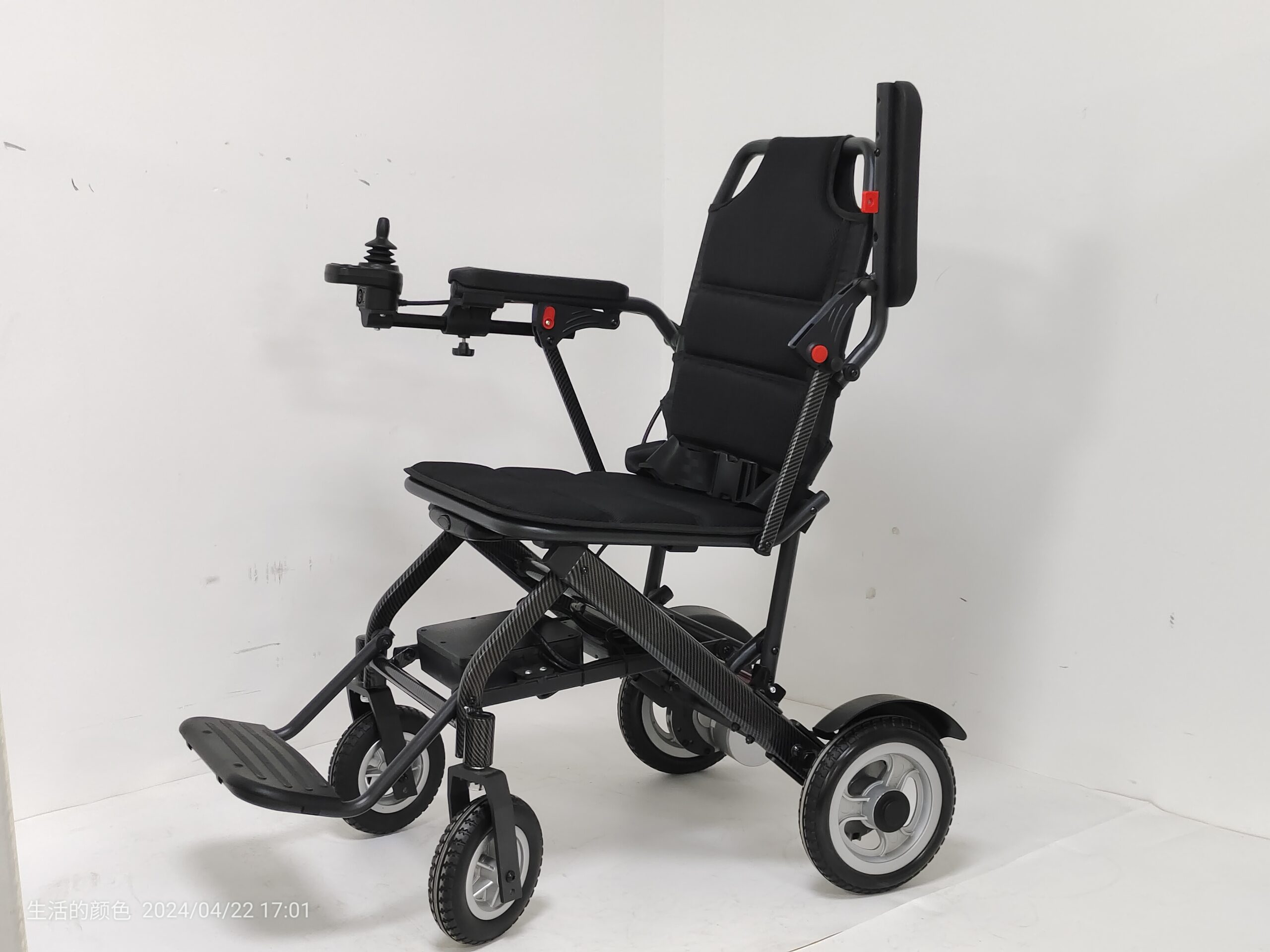Purchasing a wheelchair is an important decision that requires careful consideration of several factors to ensure it meets the user’s specific needs.
We need to understand the user’s mobility needs, as these will heavily influence the type of wheelchair required. For example, the choice between a manual wheelchair and an electric one largely depends on the user’s upper body strength and the need for independent maneuverability.

Measurement and fitting are vital to comfort and prevent health issues like pressure sores or poor posture.
Measuring the seat width, depth, and height of the chair is crucial to match the user’s body dimensions.
Moreover, we should also consider financial aspects, which involve understanding insurance coverage, available funding, and the overall cost-effectiveness of the purchase.
For those who require guidance on the types of wheelchairs, navigating through the options, and insight into purchasing and paying for a wheelchair, learning the basics about wheelchairs can be incredibly beneficial.
Key Takeaways
- Assessing mobility needs dictates the kind of wheelchair suitable for the user.
- Accurate measurements are crucial for a comfortable and safe wheelchair fitting.
- Understanding financial options can make purchasing a wheelchair more manageable.
Understanding Your Mobility Needs

When selecting a wheelchair, it’s vital to contemplate how it will fit into your day-to-day life and accommodate any limitations. It’s not just about purchasing a set of wheels; it’s about enhancing your independence and quality of life.
Assessing Lifestyle and Daily Activities
To identify the wheelchair that best matches your lifestyle, ask yourself the following questions:
- Where will I be using the wheelchair the most?
- Indoors, outdoors, or a combination of both
- What daily activities will I engage in?
- Cooking, working, shopping, socializing
- Will I be traveling frequently?
- Portable and lightweight models are essential for users who need a wheelchair that supports an active lifestyle.
Also, consider the environment around you. These factors will influence your choice if you frequently encounter uneven surfaces or need to navigate tight spaces.
Your ability to independently operate the wheelchair is also crucial – if you anticipate long periods of use or frequent travel over diverse terrains, a power wheelchair might be necessary. For more detailed information, applying for a needs assessment by social services might be beneficial.
Considering Mobility Limitations
Your physical capabilities play a decisive role in the type of wheelchair needed. Reflect on the following: leg rest adjustments, folding mechanisms, leg rest adjustments, and folding mechanisms.
- Upper body strength and stamina:
- Can influence whether a manual or power wheelchair is best
- Balance and posture needs:
- Certain wheelchairs offer better support features
- Severity and type of mobility issues:
- Conditions such as paralysis, amputations, or degenerative diseases significantly influence how to choose a wheelchair.
Remember, your experience with wheelchairs can impact the adaptation period for a new device. If this is your first wheelchair, you might prioritize different features than if you are an experienced user.
Professional guidance can help assess the appropriate wheelchair for your condition, as can resources that discuss the technical and specialized areas of wheelchair seating and mobility.
When selecting a wheelchair, don’t overlook your long-term health. Choosing a chair that fits your body properly can prevent additional health problems.
Consulting with healthcare providers for a wheelchair prescription can also help ensure that your specific health needs are met and that you make an informed decision that complements your mobility requirements.
Types of Wheelchairs

When selecting a wheelchair, it’s crucial to consider the different types available, each catering to specific needs and lifestyles.
Manual Wheelchairs
The user or an assistant propels manual wheelchairs. They are typically lighter than power wheelchairs and more portable.
These chairs come in standard and lightweight varieties.
Lightweight models are easier to transport and maneuver, making them ideal for users with an active lifestyle.
Sports wheelchairs, designed for wheelchair users with an active lifestyle, are a subset of manual chairs designed for athleticism and agility, often featuring a more aerodynamic design.
Power Wheelchairs
Power wheelchairs are equipped with a battery-operated motor and are controlled via a joystick.
These are suitable for individuals who lack the strength or endurance to propel a wheelchair manually. These chairs allow for greater independence, as they do not require a companion for propulsion.
Transport Wheelchairs
Transport wheelchairs are designed for short trips and easy storage. They are lighter than standard wheelchairs and often have smaller wheels, making them easier for a companion to maneuver.
They’re an excellent choice for moving a person from one point to another over short distances.
Specialty Wheelchairs
Specialty wheelchairs cater to specific medical and functional needs.
For example, reclining back wheelchairs offer adjustability for users who frequently need to change their position for pressure relief or comfort—a feature researched for its beneficial impact.
Other specialized chairs are tailored for different body weights, sizes, and conditions, ensuring a custom fit for improved support and functionality.
Tips for Comfort and Safety
When choosing a wheelchair, comfort and safety should not be compromised. Comfort ensures the wheelchair user can spend extended periods in the chair without experiencing pain or discomfort. In contrast, safety minimizes the risk of accidents and injuries. Here are some essential tips to consider:
- Select a well-designed wheelchair cushion that assists in distributing weight evenly, reducing the risk of pressure sores and enhancing overall comfort.
- Assess the back support. A chair with proper lumbar support will promote better posture and reduce strain on the back.
- Test drive the chair for stability. Ensure it feels stable during various maneuvers without tipping.
- Opt for anti-tippers to prevent the Wheelchair from falling backward.
- Examine braking systems for ease of use and reliability.
- Look for wheelchairs with safety belts if the user has balance issues or tends to slide forward.
Maintaining the perfect balance between comfort and safety will result in a more enjoyable experience for the wheelchair user.
Key Wheelchair Features

When selecting a wheelchair, certain features are vital for ensuring comfort, functionality, and longevity. We’ll examine the key essential components when choosing the right wheelchair.
Wheel and Tire Types
Wheelchairs come with different wheels and tires, each suited for specific conditions. Performance wheelchairs often have lightweight wheels and smoother tires for easier maneuverability and speed.
Pneumatic tires are air-filled, providing a softer ride, while solid tires offer durability without inflation. Casters in the front are smaller wheels that affect turning and overall stability.
Seats and Comfort
The chair’s seat is a critical factor for user comfort. Seat width and seat depth should be tailored to the individual’s measurements, allowing enough room for ease of movement and proper circulation.
For comfort, look for high-quality upholstery and cushioning that can endure everyday use. Contoured seats support posture and help distribute weight evenly.
Weight Capacity and Frame
Weight capacity is a crucial specification, as it needs to comfortably support the user’s weight without strain on the frame. Standard wheelchairs support around 250-300 pounds, while heavy-duty models, including transport chairs renowned for their durability. can accommodate more. Regarding the frame, rigid frames offer durability and lightweight materials such as aluminum or titanium, which enhance the chair’s ease of transport and wheeling efficiency.
Customizations and Accessories
Customizing a wheelchair can dramatically improve its utility and the user’s independence. Accessories such as cushioned armrests, adjustable footrests, and storage bags can be conveniently added.
Performance enhancements like shock absorbers or ergonomic handrims enhance the driving experience. It’s important to consider which modifications will benefit your lifestyle most.
Understanding and comparing these features will guide you in selecting the best for your needs. If you require additional information on choosing the right wheelchair, consider exploring guidance from trusted resources.
Financial Considerations

When considering a wheelchair purchase, understanding the financial aspect is crucial. We’ll discuss how various insurance plans, including Medicare, can impact your buying decision and the importance of budgeting for this investment.
Insurance and Medicare Coverage
Medicare: Often, Medicare can partially or fully cover the cost of a wheelchair if it’s deemed medically necessary.
It’s essential to know that these benefits are generally available to those who require a wheelchair in their homes. For more detailed coverage guidelines, it’s best to consult the official Medicare documentation related to wheelchair coverage.
Private Insurance: Coverage will depend on your private health insurance policy.
As policies differ, you should review your plan’s terms or speak to your insurance representative to understand the extent of coverage for durable medical equipment like wheelchairs.
Budgeting for Wheelchair Purchase
Cost Considerations: Wheelchair prices vary widely, with manual wheelchairs generally being less expensive than power wheelchairs with the best wheelchair often being more individualized. Due to their technological components, power wheelchairs can be quite expensive, sometimes costing several thousand dollars.
Allocating Funds: It’s important for us to allocate a reasonable budget for the wheelchair purchase, considering the potential long-term benefits of a higher-quality chair against the immediate financial costs. This may include looking at the total cost of ownership, such as maintenance and potential accessories required for optimal use.
Crafting a comprehensive budget plan will ensure that we manage our finances effectively while securing a wheelchair that meets our needs.
Measuring and Fitting

When purchasing a wheelchair, it’s essential to get accurate measurements to ensure a secure and comfortable fit. We’ll guide you through determining the correct seat size and the importance of back height and armrests, which are crucial for comfort and support.
Determining the Correct Seat Size
The seat size is foundational to a wheelchair’s comfort and usability. To measure the seat width, have the user sit on a flat surface, measure the widest part of their hips, and then add approximately two inches for clearance. This extra space prevents pressure points and allows room for clothing. Correctly determining the seat width for a wheelchair ensures adequate support and distribution of the user’s weight.
For seat depth, measure from the back of the buttocks to the inner knee. Subtract one inch from this measurement to prevent the edge of the seat from putting pressure on the back of the knees. A properly sized seat depth supports the thighs evenly and decreases the risk of sliding.
Importance of Back Height and Armrests, a critical wheelchair accessory,
Back height is vital for providing adequate support for the wheelchair user. Measure from the seat’s surface to the bottom of the user’s shoulder blade for the correct back height. If the wheelchair will be used for various activities, choosing a wheelchair with adaptable features is crucial. active propelling, a lower back height may be preferred to allow for greater freedom of movement.
Armrests are essential for posture and balance. To determine the proper height, measure from the chair seat to the elbow when the user’s arm is at a ninety-degree angle. The armrest should comfortably support the arm without shrugging the shoulders or slouching.
Combining these measurements, you can find a wheelchair that fits the user well, ensuring comfort and reducing the risk of complications from improper fit.
Where to Buy a Wheelchair

When purchasing a wheelchair, our primary options typically include local medical supply stores and online wheelchair retailers. Each option has distinct advantages that we’ll need to weigh based on our specific needs.
Local Medical Supply Stores
Shopping at local medical supply stores allows us to view physically and test wheelchairs. This can be crucial for ensuring a proper fit and comfort. We can:
- Interact directly with sales staff: This allows us to ask questions and receive immediate answers.
- Immediate purchase: If a suitable wheelchair is in stock, we can take it home the same day.
- Personalized service: Physical stores may offer services such as wheelchair fitting and customization.
It’s helpful to remember that store inventory may be limited, and prices can be higher than online retailers.
Online Wheelchair Retailers
Purchasing a wheelchair from an online retailer can offer a wider selection and, often, more competitive pricing. When browsing online, we should:
- Consult product reviews: These can offer us insights into the durability and functionality of the wheelchairs.
- Check return policies: It’s crucial to understand how to return a product if it doesn’t meet our needs once it arrives home.
- Verify warranty and service options: Many online retailers provide warranties, and some may also offer service contracts.
By shopping online, we can conveniently compare different models from our homes. However, the lack of physical experience with the product before purchase can be a drawback, so it’s vital to research thoroughly.
Evaluating Wheelchair Brands and Retailers

When selecting a wheelchair, it’s crucial we assess the brands and retailers carefully to ensure we’re making an informed decision that meets our specific needs. This section will guide us through the considerations for reputation and customer support.
Reputation and Reviews
We always start by examining a brand’s reputation. Established brands with a lengthy presence in the market are often synonymous with reliability. For example, Pride Mobility and ComfyGo Mobility are known for their quality construction and diverse product offerings.
It’s essential to check customer reviews. We look for patterns in feedback on various wheelchair models, including the experiences users had with them and any recommended wheelchair accessories. Online shopping platforms typically feature user ratings, which can be a valuable source of information. Here’s how we can summarize the review-checking process:
- Look at overall customer satisfaction ratings.
- Read through a mix of positive and negative reviews.
- Note any recurring complaints or praises about comfort, durability, or functionality.
Customer Support and Services
Customer support is a pillar of the shopping experience. We ensure that the retailer or brand offers comprehensive support services, such as:
- Online support: through the retailer’s or manufacturer’s website.
- Phone support: to allow direct communication for inquiries and issues.
- After-purchase services, including warranties, parts replacement, and repair services.
Detailed after-sale support can significantly impact our experience, particularly if we’re new to using wheelchairs or if specific needs arise. Here’s what we examine:
- The warranty policy’s length and coverage.
- Availability of replacement parts and their delivery times.
- The accessibility of support services ensures they are user-friendly, especially for the less tech-savvy.
By scrupulously evaluating the reputation and customer support offered by wheelchair brands and retailers, we align ourselves with choices that can provide an optimal wheelchair shopping and ownership experience.
Preparing for Long-Term Use

When planning for long-term wheelchair use, considering how to maintain mobility and independence is crucial. Well-maintained wheelchairs and proper adaptation for comfort and usage underlie successful long-term reliance on these mobility aids.
Maintenance and Repairs
For both manual and electric wheelchairs, routine maintenance ensures function and longevity. Create a schedule to:
- Check and inflate tires
- Tighten loose bolts and fasteners
- Inspect and replace worn-out wheelchair parts, such as cushions and armrests
- Assess batteries and motors in power wheelchairs for performance.
It’s important to have a reputable repair service in mind. Keeping spare parts when possible aids in preventing downtime.
| Maintenance Task | Frequency | Notes |
|---|---|---|
| Cleaning Frame | Weekly | Use a damp cloth and mild soap |
| Wheels/Tire Inspection | Monthly | Check for alignment, tightness, and pressure |
| Battery Care (for Electric) | As per manufacturer | Keep charged, do not deplete fully |
| Brakes Maintenance | Monthly | Adjust and ensure a secure grip |
| Fastener Check | Bi-monthly | Tighten any loose parts |
| Upholstery Inspection | As needed | Clean and replace when worn |
Adaptation and Transition
Transitioning to long-term wheelchair use requires adaptation of both the user’s environment and the user’s techniques to maintain independence. Considerations include:
- Ensuring living spaces are wheelchair accessible
- Learning and practicing mobility techniques for different terrains
- Utilizing accessories that enhance mobility, such as cushioning for comfort during prolonged use
Remember that some people find wheelchairs to retain independence in the face of illness or injury. Selecting a chair suited to your lifestyle and mobility needs is essential, whether a manual or electric wheelchair.
Frequently Asked Questions

When selecting a wheelchair, it’s essential to consider the user’s specific needs, including comfort, cost, functionality, and the environment in which the chair will be used.
How much does a decent wheelchair cost?
The cost of a decent wheelchair can vary depending on the type and features you are looking for. Manual wheelchairs can range in price from $150 to over $1,000. An electric wheelchair from YveeltMedical costs approximately $300 to $2,000. It is important to consider your budget and needs when choosing a wheelchair.
How do I choose the right wheelchair for an elderly individual?
We understand that elderly individuals may need wheelchairs that provide extra support and comfort. Look for features such as cushioned seating, adjustable components, and easy-to-use controls, especially if they have limited mobility or strength.
What factors should I consider when selecting a wheelchair for long-term use?
For long-term use, durability and adaptability are key. We recommend wheelchairs with high-quality frames, pressure-relieving cushions, and the ability to add accessories as the user’s needs evolve.
How do I know what size wheelchair to buy?
When determining what size wheelchair to buy, consider the following factors:
- Your weight capacity: Make sure your chosen wheelchair can support your weight. Most wheelchairs have a weight capacity of up to 250 lbs, but if you weigh more than that, you may need a heavy-duty wheelchair with a higher weight capacity.
- Chair width: Measure the width of your hips to ensure the wheelchair seat is wide enough for comfortable sitting. Wheelchairs typically come in three seat sizes: narrow (16″), medium (18″), and wide (20″+).
What indicators might indicate that it is time to consider using a wheelchair?
Indicators for a wheelchair user include decreased mobility, increased fall risk, or exhaustion from walking. When activities of daily living become challenging without assistance, a wheelchair can help maintain independence.
What are the features of a good outdoor wheelchair?
A good outdoor wheelchair should have durable tires for various terrains, a sturdy frame, and possibly suspension for comfort. It should also offer ease of maneuverability and stability.
What is an estimated cost range for a quality wheelchair?
Quality wheelchairs can range significantly in price, from a few hundred dollars for basic models to several thousand for advanced, motorized options. The cost is influenced by the specific features and materials used.






